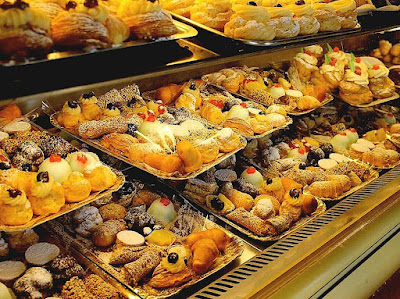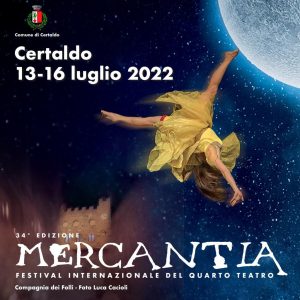Last Saturday, when temperatures were down slightly, I paid a visit to Lucca, that lovely walled town in the west of Tuscany. I had forgotten just how pleasant Lucca is for a stroll - so compact, beautiful, full of things to see and virtually free of motorised vehicles within the walls.
The main things to see in Lucca are described on the Lucca Tourist Information website. Here I want to describe some of the things that I personally enjoyed on this visit.
Map of Lucca
I arrived by train from Florence (1 hour 20 minutes) walked to the main entry portal of Lucca, Porta San Pietro, and followed my favorite route past Piazza Napoleone to Piazza San Michele to visit the church and admire there the very fine glazed, terracotta bas-relief by Luca della Robbia.
The piazza was baking in the sun but luckily Lucca's streets are, for the most part, narrow and therefore shaded. Lucca is also noticeably well-endowed with excellent pasticcerie so that more than once I picked up a pastry to accompany very necessary cold drinks.
Pasticceria in Lucca
Lucca is also a remarkably good town for shopping, especially taking into account its small size. There are certain towns in Tuscany that attract wealthy visitors from nearby vacation areas and which therefore offer very high quality stock. Pietrasanta for example, attracts clientele from Forte dei Marmi and environs. Lucca is similar but, because of the large general tourist traffic, has in addition many moderately priced shops selling beautiful ladies' clothes, as well as a good number of leather goods and jewellery shops - the most famous of the latter is Gioielleria Carli, which has been owned by the same family since the 1600's. I found that Marchi, on via S. Lucia, had the best stock of "non-industrial" jewellery. Many of the others sell inexpensive "fashion jewellery".
In fact, the small size of Lucca, as for Pietrasanta, is a part of what makes the shopping good - there are a few streets packed with interesting stops all within an easy walk of one another. I leave aside the salumerie which, although attractive and full of good offerings, are not different from similar places scattered more diffusely in Florence and elsewhere. Via Fillungo is the main shopping street with many unique shops but also rather too many designer outlets selling the same old stuff. However, in the streets round about - via S. Lucia, for example - you will find many individually-owned clothes shops currently selling very nice linen outfits, among many other skirts, dresses and tops.
Next, time for lunch. Lucca is very well-provided with good quality restaurants. Prices are slightly higher than elsewhere in Tuscany but on the whole the quality of the dishes is very good. I went to my favorite - and the favorite of a great many others - Osteria Rosolo which is located in a small and quiet piazza, Corte Campana, off Via Pozzotorelli which exits the Piazza San Michele on its SW corner. As its name says, Osteria Rosolo is an osteria (a trattoria, a small eating house) and it offers more or less standard Tuscan fare (plus lamb chops). I come here for two reasons - the TASTE of the food is exceptional and the service is incredibly welcoming, informal and flexible. They have an indoor, air conditioned dining room but despite the general temperature, the tables outside were delightfully cool under the umbrellas. I was very hungry so I had linguine with vongole (both fresh and delicious) with a glass of local white wine. It was a trebbiano, a highly productive grape which usually yields a faîrly bland wine, but in this case it was excellent. Next, a fillet steak on toast with a sauce of mustard, cream and green pepper corns - fabulous, and cooked exactly to the degree I requested. With that I had a glass of cabernet sauvignon from Bolgheri - plus plenty of cold water. They willingly put my red wine in the fridge for a few minutes to cool it down a bit, an act of sacrilege forced upon me by the current heat wave.
Fillet of beef at Osteria Rosolo in Lucca
For the afternoon, I picked two sights quite unique to Lucca, the Palazzo Pfanner and the Botanical Gardens.
Palazzo Pfanner (also known as Palazzo Controni) was constructed in 1660 and is now the home of the Pfanner family. Felix Pfanner (1818-1892), a brewer from Hörbranz on the shores of Lake Constance, came to Lucca and founded a famous brewery. He eventually bought the Palazzo from the Controni family. Pietro Pfanner (1864-1935) was a surgeon, philanthropist and Mayor of Lucca from 1920-1922.
As my intelligent and discerning readers will recall, I am a garden nut, and you can safely believe me when I say that the small garden of Palazzo Pfanner is delightful, especially on a hot day. There I relaxed in the shade. The garden is surrounded by high shrubs and bamboo so that only the fine campanile of the Basilica di San Frediano is visible. In summer the big terracotta pots holding the lemon trees are dotted around - these are housed in the limonaia during the winter months. A short walk bordered by larger than life marble statues leads to a small pond with a simple fountain in the middle of it. The best view of this walk is from the splendid loggia of the palazzo. The apartments of the palazzo that are open to the public are of moderately interesting, and among other things display some of the surgical equipment of Pietro Pfanner. The main reason for ascending the grand staircase is the view it affords out over the garden.
My next and last visit for the day was to the Botanical Gardens in the SE corner of Lucca. They can be reached from Palazzo Pfanner via the Piazza del Amfiteatro (well worth a brief visit - some of the stonework of the Roman amphitheatre can be seen in the walls of the apartment buildings now delineating the outline of the amphitheatre) and the Torre Guinigi, the famous tower with the trees growing on top of it, and then following the Via del Fosso and its fast flowing canal.
The Botanical Gardens in Lucca - Sequoia sempervirens
For such a small town, Lucca has an excellent Botanical Garden, with specimens ranging from a giant sequoia to a good collection of insectivorous plants. They have a huge ginkgo tree, surely one of the first specimens planted in Europe. Ginkgo leaves were known from fossils dating as far back as the Permian period. The last surviving genus is native to China and was first described by Engelbert Kaempfer in 1690 based on a tree he saw in Japan. Specimens soon found there way into botanical gardens throughout the Western world. Not only the plants are interesting. While I was at the gardens, a beautiful hoopoe was busily digging up worms just a few meters away from me. I could spend hours in these gardens and will surely return to them.
I suppose being sensitised by an afternoon of plants, I couldn't help but be fascinated by the miles and miles of tree and shrub nurseries in the Arno flood plain visible from the train back to Florence. It reminded me yet again how horticulture dominates the rural economy of Tuscany.
More about Lucca: https://www.lucca.info/
Lucca on Facebook: https://www.facebook.com/lucca.tuscany.italy/
|
Author: Anna Maria Baldini














